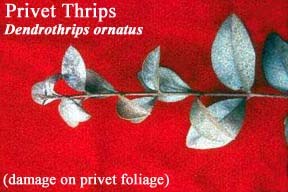Privet (Ligustrum)
Plant Health Problems
Diseases caused by Fungi:
Anthracnose and twig blight, Glomerella cingulata.
Cankers develop on main trunk near ground level. These cankers enlarge and girdle the plant. Leaves above the canker turn pale green, then brown, and remain attached for awhile. Infected bark is brown, and wood beneath is brown or greyish black.
Use of resistant varieties appears to be the most effective method of control.
Stem galls, Phomopsis sp.
Galls 1-1/2 inches in diameter are formed on trunk and branches. Heavily infected plants may die.
No effective controls have been identified.
Powdery mildew, Microsphaera penicillata.
White mealy appearance on upper surface of leaves indicates this fungus. This disease is favored by hot humid weather.
Powdery mildew can be minimized by improving air circulation around the plant. Chemical control is usually not necessary.
Root rot, Armillaria mellea.
Leaves are small, growth is slow and followed by dieback of branches and death of parts of the hedge. Black fungal strands resembling shoestrings may be found in the soil around the roots and main trunk. Rotted bark may show white mycelial fans on the underside.
Control of Armillaria depends on removing all wood, dead and alive, from the soil. In addition, the fungus is completely intolerant of drying, so the chances of spreading the fungus to uninfected plants will be reduced by thorough drying of wood chips and leaf mold before using them as a mulch or amendment.
Insect Problems
Twobanded japanese weevil, Callirhopalus bifasciatus.
The beetles vary in size, up to 1/4" long, and vary from light to dark brown. The adults especially favor feeding on tender shoots. Acephate or fluvalinate, which are some of the products registered for control of this pest in Connecticut, applied in late July and mid-August can control the adults. Consult the labels for dosage rates and safety precautions. Larvae, which feed on roots in the ground, may be controlled with insect pathogenic nematodes.
Leafroller, Archips rosana.
This small caterpillar webs together the terminal leaves of California privet in May, making a case within which it lives and feeds. When fully grown, it is 3/4" long, and green with a dark brown head. It pupates in the webbed leaves and the moths emerge about the middle of June. The forewings vary from light brown to olive brown and are crossed by darker markings. The eggs are laid in June on the twigs and remain there and hatch the following spring. As most of the webbed leaves are clipped off in trimming the hedge no other control measures are necessary. Spraying with Bacillus thuringiensis var. kurstaki or spinosad will control damaging populations of leafrollers.
Lilac borer, Podosesia syringae.
The larvae bore into the stems of lilac and privet. It is white or yellowish with a dark brown head. The moths emerge late in May, and the females lay eggs in patches on roughened places in the bark. The larvae tunnel in the solid wood and sometimes in the pith for a distance of 8 to 10". Foliage wilts and eventually the branches die back. The insects also cut across the grain so that the branch breaks. The larva pupates in the burrow after cutting a passageway to the bark. On emergence, the adult leaves the pupal case protruding from the burrow. There is one generation each year. The moth is a wasp-like clearwing, with wingspan of from 1 to 11/2".
Mites.
Several species of non-web forming mites infest the tender tips of California privet, including the privet mite, Brevipalpus obovatus. In spring and early summer, the leaves may become stunted, thickened and curled. Some damaged leaves drop. Among the compounds registered for control of this pest in Connecticut are insecticidal soap and ultrafine horticultural oil. Spraying with insecticidal soap will give good control if applied at least twice at 7-10 day intervals. The predatory mite, Neoseiulus fallacis, is most commonly found feeding where there are mite infestations. A single application of ultrafine horticultural oil (1/2 - 1% dilution) can be effective if predatory mites are present.. Consult the labels for dosage rates and safety precautions. Special care should be taken with soap or oil to obtain thorough spray coverage, because they only work on contact. Hexythiazox or abamectin (a restricted use product) are also effective miticides. Avoid applying carbaryl or pyrethroids, which tend to be much more toxic to beneficial predatory mites than to the pest mites.
 Privet thrips, Dendrothrips ornatus.
Privet thrips, Dendrothrips ornatus.
Immatures are yellowish and adults are dark brown or black with a bright red band. This insect injures privet by puncturing cells and sucking out their contents. The leaves become whitish, and speckled on the underside with specks of dark excrement. Among the compounds registered for control of this pest in Connecticut are acephate, insecticidal soap, spinosad, or ultrafine horticultural oil. All should be applied as foliar sprays when insects are present. Multiple applications may be necessary. Consult the labels for dosage rates and safety precautions.

